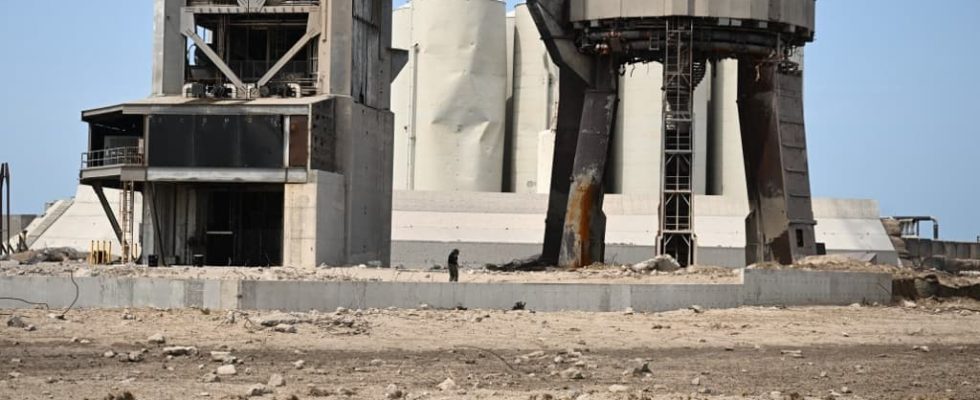The company “wrongly” thought it would withstand the test, admitted Elon Musk. Before being able to fly again, in addition to reinforcing its launch pad, SpaceX will have to determine the cause of the problems encountered in flight.
Chunks of concrete ejected, bent metal and craters dug into the ground… The force of the first takeoff of SpaceX’s new rocket, Starship, both the largest and most powerful in the world, has seriously damaged its launch pad in Texas.
The damage caused will likely take several months to be repaired. They could thus delay the next test flights, and therefore the development of this rocket on which NASA is quickly counting to send its astronauts back to the Moon.
“Broken the Concrete”
Before Thursday’s test flight, SpaceX boss Elon Musk’s only wish was “not to destroy the launch pad.” His fear: that the rocket would explode before it even tore itself from the ground – which it finally did after four minutes of flight, above the sea.
But the company seems to have underestimated the damage that a simple takeoff of this 120-meter-high mastodon could cause.
“The engines, when they ignited, may have shattered the concrete, rather than just eroding it,” Elon Musk tweeted on Saturday.
Several months of repair
The gigantic launch tower withstood the shock. The huge base on which the vehicle rests (launch table) is also still there, even if it has been damaged. But under him, a deep crater has been dug, according to images published by specialists on social networks.
All around reigns a landscape of desolation. During takeoff, a shower of debris was catapulted into the nearby sea, SpaceX video shows. A cloud of dust reached a small town several kilometers away, according to local press.
“The radius of debris and nuisance was probably larger than anyone had anticipated,” said Olivier de Weck, a professor in MIT’s Department of Aeronautics and Astronautics.
“The main damage to the launch pad is below, where the flames (from the engines) attack the ground,” explained Olivier de Weck, several of whose former students work for SpaceX. “The crater that has been created is going to have to be filled in and repaired, and that will definitely take several months.”
Protection not “ready in time”
Starship’s launch pad did not appear to be equipped with two facilities typically used for heavy launchers. First, a “deluge”: phenomenal quantities of water poured out at the precise moment of the ignition of the engines, in order to attenuate the acoustic waves, limiting the vibrations.
Then, a “jet deflector” (or flues): a system of tunnels allowing the emitted gases to be redirected, protecting both the concrete and the rocket. But building them is extremely expensive, especially since they must be adapted to the size of the rocket – disproportionate in the case of Starship.
After the test, Elon Musk explained that the company had started building “a steel plate cooled by water” to be placed under the base of the rocket, ultimately not “ready in time”.
The company “mistakenly” thought the launch pad would withstand the test, he admitted, adding that a new launch would probably be possible “in one or two months”.
“More a success than a failure”
Such a steel plate “would make sense, I think it will work,” said Philip Metzger, a former NASA employee who worked on launch pad physics. Spraying it with water would prevent the plaque from “melting”, he explained.
This would not solve the problem of acoustic waves, but “you can build a rocket strong enough to withstand it”, estimated this scientist at the University of Central Florida. Designing a launch pad is as complex as developing a rocket, he pointed out.
NASA’s new mega-rocket, SLS, which took off for the first time in November from Florida, had also caused damage, in particular putting out of service the elevators of its launch tower.
Before being able to fly again, in addition to reinforcing its launch pad, SpaceX will have to determine the cause of the problems encountered in flight. Several engines failed, and the rocket’s two stages failed to separate as expected, forcing SpaceX to activate the self-destruct command.
Finally, it will be necessary to convince the air regulator, the FAA, to authorize Starship to take off again, noted Olivier de Weck. The agency confirmed that the test on Thursday did not cause any injuries, and said it was overseeing the investigation into the explosion. She assured that a new test flight would be conditional on public safety.
Counter-intuitively, this first test remains “more a success than a failure”, according to Olivier de Weck. “SpaceX gets to develop these amazing capabilities, because they’re willing to take risks and break things – but they learn from it.”

